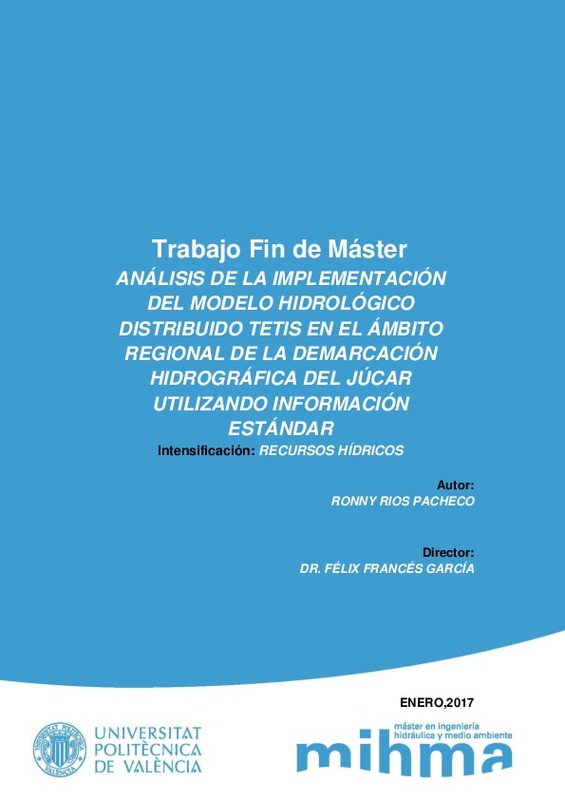|
Resumen:
|
[EN] The present work called "Analysis of the implementation of the distributed hydrological model TETIS in the regional ambit of the hydrographic demarcation of the Júcar using standard information ", has as main objective ...[+]
[EN] The present work called "Analysis of the implementation of the distributed hydrological model TETIS in the regional ambit of the hydrographic demarcation of the Júcar using standard information ", has as main objective of study the analysis of the hydrological behavior on different areas of the Confederation of the Júcar, using the model TETIS, in order to generate information that can be used for the modeling in basins not gauged and in the hydrological characterization of the region.
The development of this work will be based on the application of a distributed hydrological model called TETIS developed by the IIAMA of the Polytechnic University of Valencia. The model integrates different hydrological processes which can generate variables useful for the analysis of water resources. The necessary data in the hydrological modeling is the series of meteorological data, data of soil, soil and hydrographic features of the basin cover.
The study area shall cover all the Confederación Hidrográfica del Júcar, taking into account specifically 10 watersheds for the study, according to its location. Hydrometeorological information will be obtained for the records of precipitation and temperature, by the project SpainV02 version Spain02V4 (1971-2007), prepared by the State Meteorological Agency AEMET and the group of the University of Cantabria - UNICAN, with daily resolution. Flow records will be obtained from the Centre for Studies and Experimentation Public Works - CEDEX with daily resolution.
It will be done the analysis of the hydrological response to daily scale, 10 gauge stations will be used which were chosen according to its location and quality of data, which will be used for calibration and cross-validation of the hydrological model. It will be done the analyze the effect of snow modelling, likewise the importance of introducing explicitly the changes produced in karst areas.
[-]
[ES] El presente trabajo denominado "Análisis de la implementación del modelo hidrológico distribuido TETIS en el ámbito regional de la demarcación hidrográfica del Júcar utilizando información estándar", tiene como objetivo ...[+]
[ES] El presente trabajo denominado "Análisis de la implementación del modelo hidrológico distribuido TETIS en el ámbito regional de la demarcación hidrográfica del Júcar utilizando información estándar", tiene como objetivo principal de estudio el análisis del comportamiento hidrológico en las distintas zonas de la Confederación del Júcar, utilizando el modelo TETIS, a fin de generar información que pueda ser utilizada para el modelamiento en cuencas no aforadas y en la caracterización hidrológica de la región.
El desarrollo de este trabajo se basará en la aplicación de un modelo hidrológico distribuido llamado TETIS desarrollado por el IIAMA de la Universidad Politécnica de Valencia. El modelo integra distintos procesos hidrológicos lo cual permite generar variables útiles para el análisis de los recursos hídricos. Los datos necesarios en la modelación hidrológica son las series de datos meteorológicos, datos de suelo, cobertura del suelo y características hidrográficas de la cuenca.
El área de estudio abarcará a toda la Confederación Hidrográfica del Júcar, teniendo en cuenta específicamente 10 cuencas para realizar el estudio, según su ubicación. La información hidrometeorológica se obtendrá para los registros de precipitación y temperatura, por parte del proyecto SpainV02 en la version Spain02V4 (1971 a 2007), elaborados por la Agencia Estatal Meteorológica - AEMET y el grupo de la Universidad de Cantabria UNICAN, con resolución diaria. Para los registros de caudal se obtendrán del Centro de Estudios y Experimentación de Obras Públicas - CEDEX con resolución diaria.
Se realizará el análisis de la respuesta hidrológica a escala diaria, se utilizarán 10 estaciones de aforo que fueron escogidas según su ubicación y calidad de datos, las que servirán para la calibración y validación cruzada del modelo hidrológico.
Se analizará el efecto de la modelización de la nieve, así mismo la importancia de introducir de forma explícita las modificaciones producidas en zonas kársticas.
[-]
|







